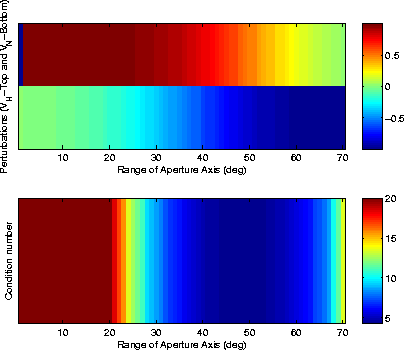The top panel of figure 3 illustrates the right-hand singular vector (two components)
associated with the smallest singular value of ![]() as the aperture-angle range changes. The
condition number is illustrated in the lower panel.
Note that when the aperture-angle range is small, the main component of the right-hand
singular vector associated with the smallest singular value is VH. Thus, when the aperture
angle range is small, the horizontal velocity cannot be accurately determined because of
insufficient data. This confirms our observation why the condition number takes large values
with small aperture data.
as the aperture-angle range changes. The
condition number is illustrated in the lower panel.
Note that when the aperture-angle range is small, the main component of the right-hand
singular vector associated with the smallest singular value is VH. Thus, when the aperture
angle range is small, the horizontal velocity cannot be accurately determined because of
insufficient data. This confirms our observation why the condition number takes large values
with small aperture data.
Eventually, when the aperture-angle range is around ![]() , the two components of the right-hand
hand singular vector associated with the smallest eigenvalue are of the same order of
magnitude. This shows that there is a slight trade-off between the two anisotropic parameters.
It is consistent with the fact that the condition number is low and that the problem is well-posed
for that range of aperture angles.
, the two components of the right-hand
hand singular vector associated with the smallest eigenvalue are of the same order of
magnitude. This shows that there is a slight trade-off between the two anisotropic parameters.
It is consistent with the fact that the condition number is low and that the problem is well-posed
for that range of aperture angles.
|
Sing_vectors
Figure 3 Top panel: Right-hand side singular vector (two components) associated with the smallest singular value of |  |
We can draw several conclusions from this theoretical study of the estimation problem as an M inverse problem.
First, assuming data are noise-free, the sampling interval of the aperture-angle axis has no impact on the estimation of the anisotropic parameters. When taking into account noise in the data, the smaller the sampling interval, the more robust the estimation of the anisotropic parameters.
Second, depending on the data available, different estimation techniques should be used.
When only small-aperture data is available, VH cannot be accurately resolved. As a
consequence, it is important to put some additional constraints on VH so that it does not take
extreme values. When large-aperture data is available, VN and VH can both be estimated.
However, the preceding section showed that trying to estimate both parameters using a usual
inversion scheme leads to poor estimates. Two approaches can be used to solve that
problem: the first would be to estimate the two anisotropic parameters independently and
successively; the second would be to modify the cost function, using weighted least-squares
for example. As we seldom have seismic data with aperture range larger than ![]() in the target
of interest, the latter approach has to be preferred.
in the target
of interest, the latter approach has to be preferred.
The following table illustrates the results of the updating process for the three different synthetic cases presented above. It shows that although the velocity spectra seemed to give inaccurate results, the estimation process actually improves the overall estimation of the anisotropic parameters.
| Perturbation | Starting | Picked | Updated |
|---|---|---|---|
| perturbation |
perturbation |
perturbation |
|
| 1% Perturbation | |||
| 10% Perturbation | |||
| Isotropic pertubation |